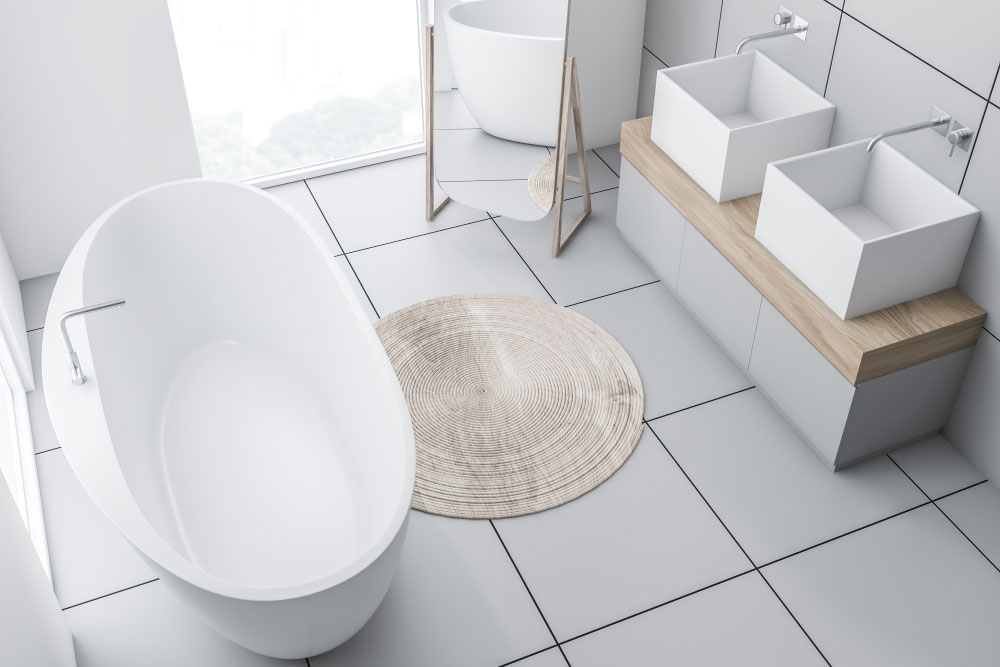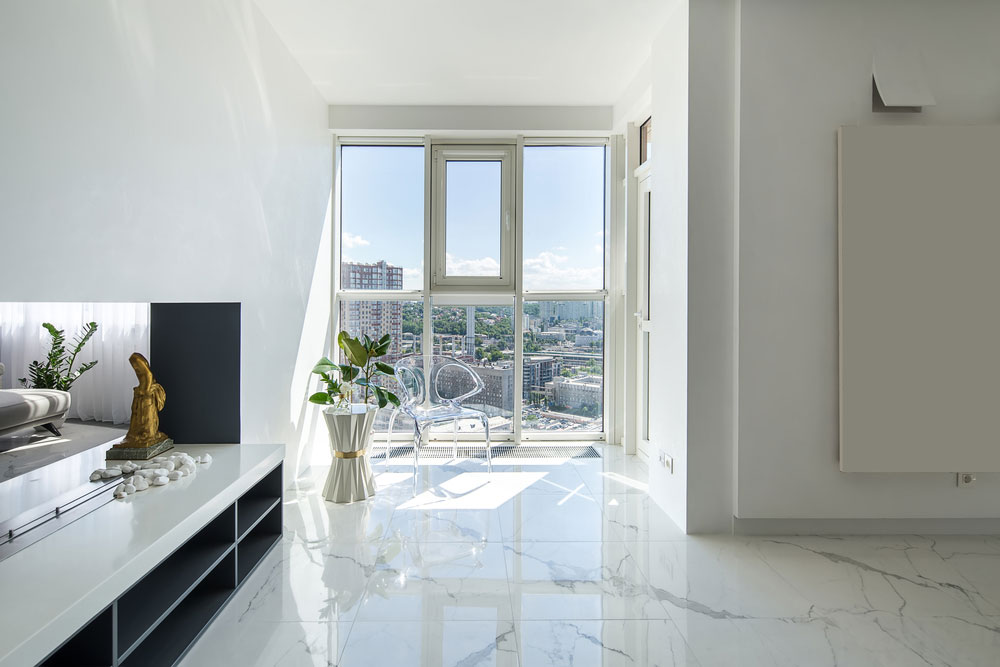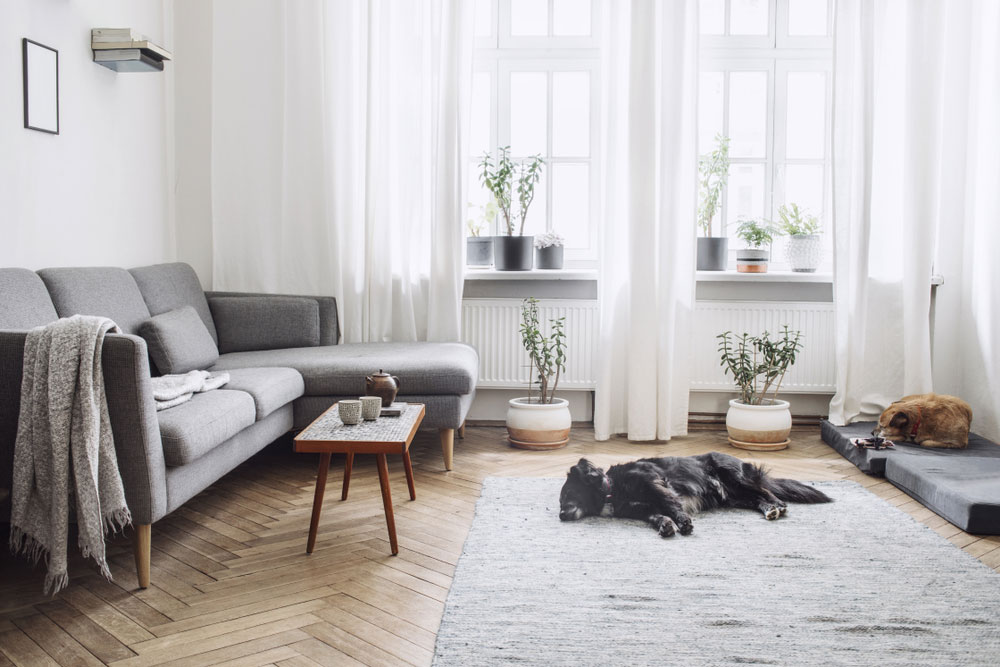Advertisement
If you’ve ever been in a funhouse, you know that flooring can seriously impact the way you perceive a space. It can create skewed perspectives—think: the illusion that there’s a giant hole or wave in the middle of your floor—and can make a space feel a whole lot bigger or smaller than it actually is. Indeed, whether you’re working with a teeny-tiny powder room or a small kitchen you want to expand, the floor is one of the best ways to achieve a roomier feel. Read on for some excellent flooring design tips for those petite spaces.
Think About Materials
Materials play a huge role not only in the longevity and performance of the floor, but also the aesthetic. We recommend choosing a material that comes in a wide variety of colors, patterns, and styles so that you can create the most expansive illusion possible. By and large, tile flooring tends to be the most variable in terms of design, whereas other popular options like hardwood and carpet are more visually static. This means you can create more unique patterns and illusions with tile. With that said, simpler and solid-colored designs create fewer visual breaks, which can prevent a space from feeling small or boxed-in. Just be sure to consider all options!
Flooring Tips for Small Spaces
Color, texture, tile placement, lighting … they all impact the flooring’s ability to expand or shrink a room. Here are some of our favorite tips for designing a floor in a small space, using these things to your advantage.
- Large-Format or Bust – Large-format tiles—those that are over 15 inches in length—have the unique ability to make your space look bigger and feel more open because they don’t break up the floor as often with grout lines and design changes as small ones do. Planning on doing it yourself? DIY’ers tend to love large-format tiles because there are fewer cuts, which means no need for a wet tile saw or any contractor-grade gear. The bigger the better when it comes to making your room look huge!

Source: ImageFlow/Shutterstock.com
- Lay Tile Diagonally – No matter if it’s large-format checkerboard floors or a small mosaic-inspired design, the pattern in which you lay the tile will affect its overall impact on the room. Laying tile in a diagonal layout is a great way to create a visual diversion because it hides out-of-square walls and naturally opens up the room. What’s more, the pros say that a diagonal pattern prevents your brain from calculating the size of a space.
- Want a Pattern? Think About Placement –Just because you’re working in a small space doesn’t mean all patterns and designs are off the table. You can still work in some excitement; you just need to create a layout that doesn’t make your space feel boxed in. One such way is to choose a continuous pattern—such as a geometric pattern or a honeycomb pattern that extends all the way across the floor with no edges—and avoid any borders around the room that could make the space feel smaller.
- Paint the Trim to Match – If you’ve got floor molding in the room, consider painting it the same color or a similar one as the floors. This will eliminate any obvious visual breaks to help make the floor look bigger than it is. You could continue the theme and paint your walls, crown molding, and windows the same color for a cool monochrome look that creates a bigger feel. Painting doors, trim, and walls the same color is super-trendy at the moment and works to your advantage if you’re playing up small spaces.
- Stick to a Solid Color or Subdued Pattern – It’s the oldest trick in the book! A solid color or subtle pattern will prevent any obvious or jarring visual breaks, which will help you create the aesthetic of a more expansive environment. Even some wood-grain patterns can be a bit too busy for small spaces. If you go with large-format tiles, stick to solids with very little graining or marbling. Avoid any small tiling, intricate patterns, and mosaic work.

Source: bezikus/Shutterstock.com
- Think About Finish – Interestingly, the finish of your tile floors can affect the way they feel in a room. If the illusion of space is your main objective, go for a high-gloss tile or plank. A glossy floor will reflect light off the surfaces around it, acting as a sort of mirror and making the room look and feel bigger than it is. Opting for a matte finish could create the illusion that you’re enclosed in a smaller space. Glossy tiles are perfect for a more glamorous space and can add a chic, artsy, or high-end feel to the room.
- Lay It Out Beforehand – One of our best pieces of advice for those looking to leverage flooring to their liking is this: Have your flooring in hand before you commit. Samples—or even orders with good return policies—allow you to physically lay out and visualize what will go where so you can see the effect for yourself before committing to a specific material or design. You never know! You just might find that you prefer the aesthetic of a certain tile over its ability to make a room feel bigger. Nothing beats a real visualization!
Flooring is one of the very best ways to make a room work for you, and you can really take it further with these great tips. Remember to think about other components of the room as well, including mirrors and wall color, to help heighten your sense of space when you’re working with limited square footage.

